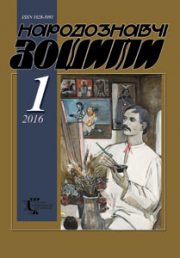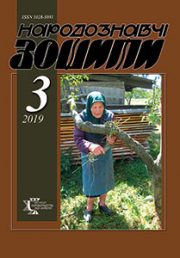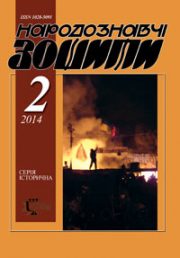The Ethnology Notebooks. 2019, № 5 (149), 1191—1199
UDK 398.81(477.83-2):[94:329.17(477)”19″]
DOI https://doi.org/10.15407/nz2019.05.1191
KRAVTSOVA Galina
Candidate of Philology
Junior research folklore department
of the Institute of Ethnology of the National Academy
of Sciences of Ukraine,
15, Svobody ave., 79000, Lviv, Ukraine.
e-mail: galynamagas@gmail.com
Abstract. The national liberation struggle of the mid XX century left a significant mark in oral folk art. In particular, a large number of songs have appeared that cover the events of that time. The Stryshchina population took an active part in the rebel movement, so you can still record the corresponding folklore here. These are mainly examples of the innovation layer that tell about the clashes of the Ukrainian underground rebels in the Striysky district, as well as poetic news about the members of the OUN, such as Vasil Bilas, Dmitro Danylyshin, Volodymyr Tymchiy-Lopatynsky, who are in the active repertoire carriers of the local folk tradition.
The article considers the peculiarity of the reproduction of reality in chronicles of the OUN and UPA period, recorded in the Striysky district. Investigated the way of displaying and combining two planes in such songs: historical realities and folklore framing. The poetics of stories is analyzed, the main attention is focused on prayers. Stressed that the texts are characterized by a peculiar schema, a constant set of motives, («the traitor leads the enemies to the rebels»; «rebels engage in battle, try to escape, shout out nationalistic mottoes»; «NKVD kill rebels / rebels commit suicide»), which can expanded by additional plot units. Exploring also reveals the features of the figurative-character composition of local songs. They are divided into three key categories, which are most characteristic for the layer of folk songs of this cycle. Representatives of the latter are characterized by a sharply negative imposition of meaning, while the rebels that belongs to the former are idealized. Songs-chronicles is an original form of perpetuating stamina, patriotism and heroism of participants in national liberation competitions. They describe examples of local manifestations of the struggle, evidencing the role of specific individuals. Despite the coverage of cases of local significance in such songs, they still retain the totality of poetic methods characteristic of rebel songs.
Keywords: songs-chronicles, poetics, motive, local specificity.
Received 11.10.2019
REFERENCES
Shankovsky, L. (1990). Essay on the history of Stryi region. Stryishchyna: East-memoir (Vol. 1, pp. 69—192). Sat. New York; Toronto; Paris; Sydney [in Ukrainian].
Demian, G. (1995). Povstanska Golgofa. Essays on insurgents. Waves of Stryi (Pp. 115—143). Stryi [in Ukrainian].
Kolessa, F. (1970). Ukrainian folk song in the newest phase of its development. Folklore works (Pp. 34—59). Kyiv: High School [in Ukrainian].
Solovyi, F. (1999). Martyrologist’s revolt of Stryishchyna in 1930—1950. Stryi: Shchedryk [in Ukrainian].
Demian, G. (1992). Twenty-five rebel songs. Ukraine in the past (Issue 3, pp. 10—42). Kyiv; Lviv [in Ukrainian].
Magas, G. (2013). Conceptual images in insurgent songs of Stryi region: traditional meanings and innovative layering Literature. Folklore. Problems of poetics: a collection of scientific works (Issue 38, pp. 147—154). Kyiv [in Ukrainian].
Yavoriv, B. (2005). Neskorny. Stryi: Shchedryk [in Ukrainian].
Hike to the grave of UPA soldiers. Retrieved from: http://www.osvitportal.lviv.ua/novyny?id=119738_pohid_do_mogyly_voiniv_upa[in Ukrainian].
The fight against the UPA and the nationalist underground: information documents of the SSS R (b) U, of the NKVD-MIA, MGB-KGB parties. 1943—1959. Book Three: 1948. (2003). Chronicle of the UPA. New series (Vol. 6). Kyiv; Toronto: Chronicle of the UPA [in Ukrainian].
Kuzmenko, О., & Pavliuk, S. (Ed.). (2017). The conception «enemy» in the interpretative paradigm of the folklore of the XX century. The Ethnology Notebooks, 5, 1086—1096 [in Ukrainian].
Lipovetsky, S. Forbidden Ukraine. Bilas and Danylyshyn. Retrieved from: http://sd.org.ua/news.php?id=17741 [in Ukrainian].
Kharchyshyn, О. (2005). Folk song of the Zvenygorod region of Lviv. Lviv [in Ukrainian].
Chikalo, O. (2010). Ukrainian songs-chronicles: genre-thematic aspect. Lviv [in Ukrainian].
Chikalo, O. (2010). The peculiarity of the reflection of the national liberation struggle of the Ukrainian people in the chronicles of the OUN and UPA. Mandrivec, 4, 61—65 [in Ukrainian].
Demian, G. (2003). Ukrainian Insurgent Songs of the 1940s—2000s (historical-folklore study). Lviv [in Ukrainian].






